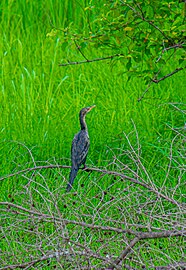| Reed cormorant | |
|---|---|

| |
| Chobe National Park, Botswana | |
| Conservation status | |
 Least Concern (IUCN 3.1) | |
| Scientific classification | |
| Domain: | Eukaryota |
| Kingdom: | Animalia |
| Phylum: | Chordata |
| Class: | Aves |
| Order: | Suliformes |
| Family: | Phalacrocoracidae |
| Genus: | Microcarbo |
| Species: | M. africanus |
| Binomial name | |
| Microcarbo africanus (Gmelin, JF, 1789) | |
| Synonyms | |
|
Plotus nanus | |
The reed cormorant (Microcarbo africanus), also known as the long-tailed cormorant, is a bird in the cormorant family Phalacrocoracidae. It breeds in much of Africa south of the Sahara, and Madagascar. It is resident but undertakes some seasonal movements.
Taxonomy
The reed cormorant was formally described in 1789 by the German naturalist Johann Friedrich Gmelin in his revised and expanded edition of Carl Linnaeus's Systema Naturae. He placed it in the genus Pelecanus and coined the binomial name Pelecanus africanus. Gmelin based his description on the "African shag" that had been described in 1785 by the English ornithologist John Latham in his book A General Synopsis of Birds. The reed cormorant is now one of five small cormorants placed in the genus Microcarbo that was introduced in 1856 by the French naturalist Charles Lucien Bonaparte.
Two subspecies are recognised:
- M. a. africanus (Gmelin, JF, 1789) – inland and coastal Sub-Saharan Africa
- M. a. pictilis (Bangs, 1918) – Madagascar (mainly west)
Description

Lake Baringo, Kenya
This is a small cormorant, 50–55 cm (20–22 in) in overall length with a wingspan of 80–90 cm (31–35 in). It is mainly black, glossed green, in the breeding season. The wing coverts are silvery. It has a longish tail, a short head crest and a red or yellow face patch. The bill is yellow.
The sexes are similar, but non-breeding adults and juveniles are browner, with a white belly. Some southern races retain the crest all year round.
Distribution and habitat
This is a common and widespread species, and is not considered to be threatened. It breeds on freshwater wetlands or quiet coasts.
Behaviour
The reed cormorant can dive to considerable depths, but usually feeds in shallow water. It frequently brings prey to the surface. It takes a wide variety of fish. It prefers small slow-moving fish, and those with long and tapering shapes, such as mormyrids, catfishes, and cichlids. It will less frequently eat soles (which can be important in its diet locally), frogs, aquatic invertebrates, and small birds.
Two to four eggs are laid in a nest in a tree or on the ground, normally hidden from view by long grass.
Gallery
-
 eggs - MHNT
eggs - MHNT
-
 juvenile
juvenile
São Tomé and Príncipe -
 adult drying wings
adult drying wings
São Tomé and Príncipe -
 Reed cormorant in Ghana
Reed cormorant in Ghana
References
- BirdLife International (2016). "Microcarbo africanus". IUCN Red List of Threatened Species. 2016: e.T22696725A93582609. doi:10.2305/IUCN.UK.2016-3.RLTS.T22696725A93582609.en. Retrieved 12 November 2021.
- Gmelin, Johann Friedrich (1789). Systema naturae per regna tria naturae : secundum classes, ordines, genera, species, cum characteribus, differentiis, synonymis, locis (in Latin). Vol. 1, Part 2 (13th ed.). Lipsiae : Georg. Emanuel. Beer. p. 577.
- Latham, John (1785). A General Synopsis of Birds. Vol. 3, Part 2. London: Printed for Leigh and Sotheby. pp. 606–607.
- Mayr, Ernst; Cottrell, G. William, eds. (1979). Check-List of Birds of the World. Vol. 1 (2nd ed.). Cambridge, Massachusetts: Museum of Comparative Zoology. pp. 178–179.
- Bonaparte, Charles Lucien (1856). "Excusion dans les divers Musées d'Allemagne, de Hollande et de Belgique, et tableaux paralléliques de l'ordre des échassiers (suite)". Comptes Rendus Hebdomadaires des Séances de l'Académie des Sciences (in French). 43: 571–579 .
- ^ Gill, Frank; Donsker, David; Rasmussen, Pamela, eds. (August 2022). "Storks, frigatebirds, boobies, darters, cormorants". IOC World Bird List Version 12.2. International Ornithologists' Union. Retrieved 20 November 2022.
- Orta, J. (1992). "Family Phalacrocoracidae (Cormorants)". In del Hoyo, J.; Elliott, A.; Sargatal, J. (eds.). Handbook of the Birds of the World. Vol. 1: Ostrich to Ducks. Barcelona, Spain: Lynx Edicions. pp. 326–353 . ISBN 84-87334-10-5.
Further reading
- Johnsgard, Paul A. (1993). Cormorants, Darters, and Pelicans of the World. Washington: Smithsonian Institution Press. pp. 147–151. ISBN 1-56098-216-0.
External links
- Reed Cormorant - The Atlas of Southern African Birds
- Reed cormorant - Species text in The Atlas of Southern African Birds.
| Order: Suliformes (Phalacrocoraciformes) | |||||||||||||||||||||||
|---|---|---|---|---|---|---|---|---|---|---|---|---|---|---|---|---|---|---|---|---|---|---|---|
| |||||||||||||||||||||||
| |||||||||||||||||||||||
| |||||||||||||||||||||||
| |||||||||||||||||||||||